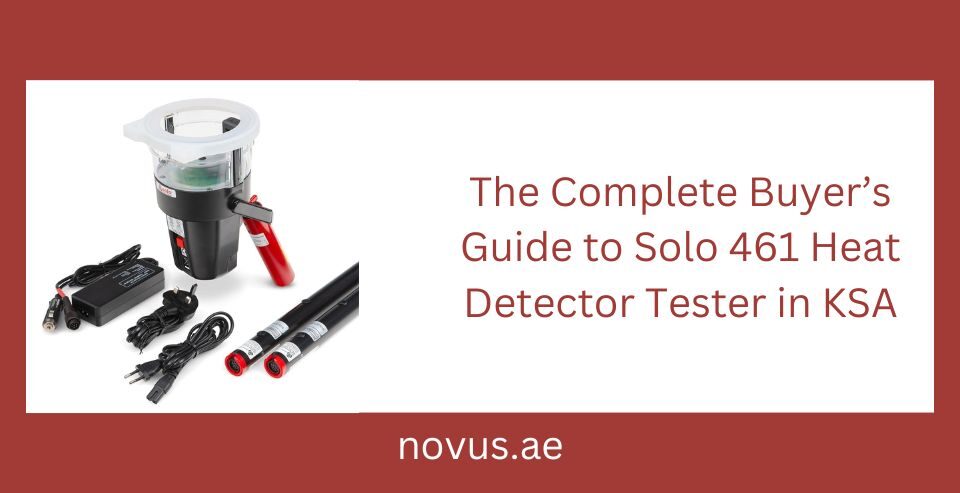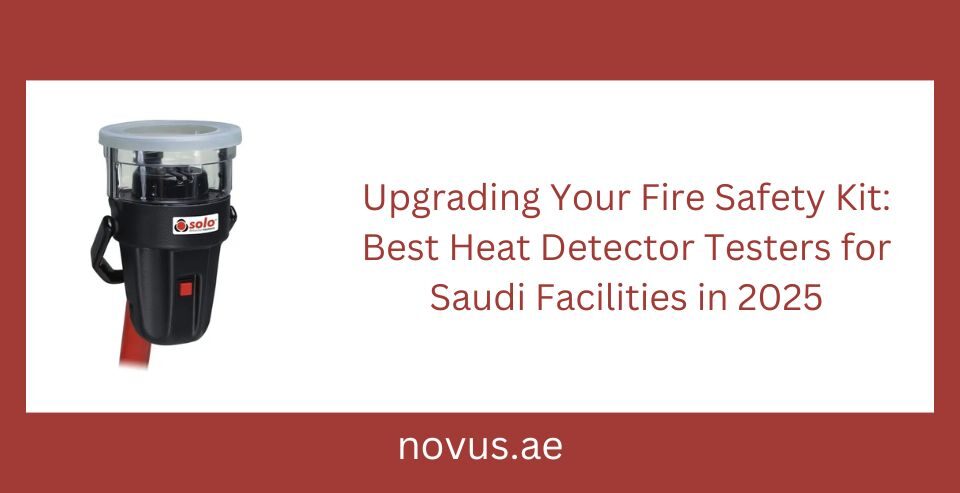
Fire Alarm Testing Checklist for Building Owners and Facility Managers in Saudi Arabia
November 7, 2025How to Find Certified Fire Alarm System Installers and Suppliers in Saudi Arabia
November 11, 2025In safety-critical environments, the need for reliable detection systems has never been greater. Building owners, facility managers, and fire‐safety professionals must rely on advanced Heat Detector Testers to verify that their systems will function when it counts. With innovations in Smoke & Heat Testing Equipment, wireless connectivity, automation, and smarter data integration, testing workflows are evolving rapidly.
A standout device, the Solo 461 heat detector tester, illustrates how modern tools are reshaping the industry—and we’ll also reference the Solo 461 heat detector tester manual as part of a broader move toward simplified technician training and documentation.
The Evolution of Heat Detector Testing Technology
Traditionally, testing heat detectors meant using bulky, cable-connected devices, manually applied heat sources and a lot of site disruption. Technicians would struggle with access, heavy gear, long test times and documentation that often lagged behind real time.
But today’s developments in detector-tester technology are changing that dynamic. For facility managers and service providers, the benefits include faster testing, less downtime, improved safety and clearer compliance documentation.
One of the major leaps forward is the introduction of cordless heat detector tester models. The Solo 461, for example, is a cordless, battery-powered tester designed specifically for heat detectors of fixed‐temperature and rate‐of‐rise types.
It uses Cross-Air Technology (CAT™) to direct heated air precisely to the sensor—reducing test time and eliminating much of the risk of damage to detectors.
Key Technological Features Driving the Change
1. Cordless and Battery-Powered Testing
The move away from main cables and trailing leads means technicians can work faster and safer. The Solo 461 kit includes rechargeable battery batons, a fast charger and a universal head unit for the tester. Having no cords to manage means fewer tripping hazards, cleaner sites and simpler logistics—especially in high-rise or challenging environments.
2. Precision Heating & Directed Air Technology
The next step was improving how heat is delivered to the detector sensor. The CAT™ (Cross-Air Technology) in the Solo 461 directs a beam of heated air horizontally across the test cup, ensuring the sensor element receives the stimulus—not the device casing. This means faster activation (in many cases, seconds) and less battery drain, improving efficiency and reducing wear on detectors.
3. Compatibility & Universal Design
Modern heat detector testers, including the Solo range, are designed to work with a wide array of detector types—fixed-temperature, rate-of-rise, and combination detectors up to certain thresholds (e.g., 90 °C / 194 °F). This universal compatibility means service teams can standardize on one tool rather than multiple brands, reducing training and inventory costs.
4. Access & Safe Reach for High or Angled Installations
Many detectors are installed at heights, on angled ceilings, or in difficult-to-reach areas. The latest testing equipment supports telescopic poles and angled heads, enabling safe access without ladders or scaffolding. This is especially important for facility managers looking to reduce downtime and improve safety during inspections.
5. Digitalisation, Connectivity & Data Reporting
Though the core of testing remains physical activation of detectors, technology is increasingly enabling digital data capture. Some devices integrate sensors that detect the LED flash on the detector, transmit test results to mobile apps or cloud portals, and generate real-time reports. This shift means better audit readiness and easier documentation and performance tracking over time.
Impact on Facility Management, Compliance & Efficiency
For building owners and facility managers, these technological advances translate into measurable value:
- Reduced downtime: Quicker tests mean less disruption to operations and tenants.
- Better safety: Faster and more accurate tests reduce the risk of false negatives or missed faults.
- Improved compliance: Digital reporting and universal compatibility help meet regulatory standards (e.g., NFPA, local codes) more consistently.
- Lower lifecycle costs: One versatile tester like the Solo 461 replaces multiple tools, reduces training and cuts maintenance overhead.
- Scalable operations: Digital data enables tracking of trends across multiple buildings, helping identify problem zones or aging detectors before failure.
Considerations Before Adopting New Heat Detector Testing Technology
While the benefits are clear, adopting cutting-edge tools requires thoughtful planning:
- Training: Even the best tool (such as the Solo 461 heat detector tester) needs users trained in correct procedures, and referencing the Solo 461 heat detector tester manual is vital.
- Budget of change: Upgrading from older cable-based equipment may require capital.
- Standard compatibility: Ensure the equipment meets local regulations and detector manufacturer approvals.
- Integration with maintenance workflows: Choose tools that fit into your existing inspection schedules, mobile apps, or asset‐management systems.
- Data security: With connectivity comes responsibility for data management, storage, and reporting security.
Looking Ahead: What’s Next in Heat Detector Testing Technology?
The future promises even more enhancements:
- All-in-one testers: Devices capable of testing smoke, heat, and CO detectors in one unit. For example, advanced models that combine smoke & heat testing capabilities.
- Automated test logging: Automatic recording of device ID, location, date/time and test outcome, reducing manual entry errors.
- Remote/robotic testing: Drones or mobile robots might soon access hard-to-reach detectors for inspection and testing.
- Predictive analytics: Use of data from testing logs to predict detector failure or service needs before they become urgent.
- Augmented reality (AR) support: Technicians using AR glasses to guide positioning, align testers, and view historical data during inspection.
The Rise of Cordless Heat Detector Testers: Solo 461 and Beyond
The advent of cordless testing equipment is a major game-changer in the fire safety industry. The Solo 461 exemplifies this shift. By removing trailing cables and enabling quick access, it boosts technician productivity and safety.
Its universal design and compatibility with the Solo pole range mean high-ceiling or angled‐surface detectors can be safely serviced without scaffolding.
When facility managers compare older equipment with modern kits like the Solo 461, the differences are clear: fewer trip hazards, less setup time, faster results and better record-keeping. As budgets tighten and expectations rise, the case for investing in smarter testing tools grows stronger.
Conclusion
Technology is reshaping how fire safety professionals test and maintain heat detectors. The transition from heavy, cord-bound tools to streamlined, cordless solutions like the Solo 461 reflects a broader shift toward efficiency, safety and data-driven maintenance.
With the integration of Heat Detector Testers, Smoke & Heat Testing Equipment, and advanced reporting tools, facility managers have better tools than ever to protect occupants, assets and operations.
Embracing these innovations—and ensuring technicians are equipped with the correct manuals, workflows and training—positions your organization for future-ready compliance, fewer service interruptions and stronger fire-safety performance.
If you’d like, I can also prepare a printable heat detector testing checklist and even an infographic comparing older equipment vs modern kits like the Solo 461—would that be helpful for your blog or client deliverable?
FAQs
Q1: What is the Solo 461 heat detector tester manual used for?
A1: The manual for the Solo 461 provides essential guidelines on operation, safety precautions, battery management, pole compatibility, and calibration checks. Following the manual ensures the tester is used correctly, maintains warranty validity, and aligns with the detector manufacturer’s requirements. A well-maintained manual supports technician training and helps document compliance workflows.
Q2: How does smoke & heat testing equipment differ from standard heat detector testers?
A2: Standard heat detector testers focus solely on applying heat stimulus to heat detectors (fixed‐temperature or rate‐of‐rise types). In contrast, combined smoke & heat testing equipment can test both heat and smoke detectors interchangeably, offering greater versatility. For facilities managing mixed systems, multi-function tools reduce inventory and simplify inspection routines.
Q3: Why choose a cordless heat detector tester over a corded model?
A3: A cordless heat detector tester, such as the one Novus Fire and Security LLC, enhances mobility, safer operation (no trip hazard from cables), faster setup, and fewer site restrictions. In high-ceiling or difficult-access areas, cordless tools allow technicians to work more efficiently and with fewer constraints. This translates into reduced downtime for the building and better overall efficiency.
Q4: Can new technology in heat detector testing really improve compliance?
A4: Yes. Advanced tools support faster, more accurate tests, better data recording, and integration with digital workflows. These features improve documentation quality and audit-readiness, reducing risk of non-compliance and providing clear evidence of due diligence. For facility managers, this means stronger support during inspections and fewer compliance issues.




